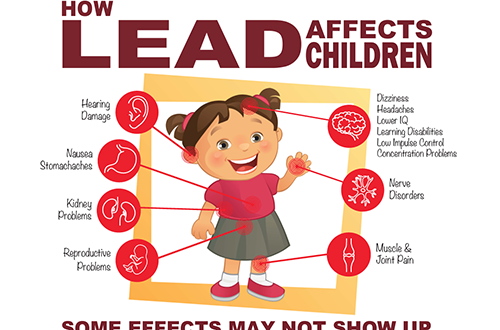Last year the National Blood Lead Level Survey report released a preliminary report of a few pages on lead contamination in a wide range of everyday items, including religious artifacts, kitchenware, spices, and household items.
However, the full report is now out on 2,400 samples across ten categories, which found that lead exposure is widespread in consumable and non-consumable items, with significant risks to public health, particularly for children.
Jinlab and Religious items
One of the most striking findings of the survey was the high levels of lead found in Jinlab, or sacred pills distributed by Lamas as spiritual blessings. Out of 767 Jinlab samples tested, 44.2% exceeded the reference threshold of 2.5 parts per million (ppm). One sample contained a staggering 57,233 ppm of lead, far exceeding safe levels. The median lead concentration in Jinlab was 85 ppm, 34 times higher than the allowable level for spices.
The survey also found a correlation between Jinlab, consumption and elevated blood lead levels (BLL) in children. Among children who had ever been given Jinlab, 78% had a BLL of 3.5 µg/dL or higher, compared to 72.1% of children who had never been given Jinlab. For children who had consumed Jinlab within the last 15 days, 84% had elevated BLLs.
Religious items, such as incense burners, butter lamps, and pendants, were found to contain high levels of lead, with 75.2% of the 214 items tested showing detectable lead. One religious pendant contained an alarming 788,537 ppm of lead. These items are often used in close contact with people during rituals, increasing the risk of lead exposure through inhalation or ingestion.
Spices
The survey tested 75 food and spice samples, with 20% exceeding the 2.5 ppm reference threshold. Turmeric and chilli powder were particularly concerning, with one-third of turmeric samples and one-fourth of chilli powder samples exceeding the threshold. The maximum lead levels in some spices were 4 to 80 times higher than the threshold. Given that Bhutanese cuisine relies heavily on spices, this poses a significant risk of lead ingestion.
Kitchenware and Lead Leaching
Kitchen items, that come into direct contact with food, were found to be a major source of lead exposure. Out of 665 kitchen items tested, 21.5% exceeded the 100-ppm threshold. Brass or metal plates, bowls, and drinking cups had the highest levels of lead, with some items containing up to 45,744 ppm. The acidic nature of Bhutanese cuisine, which includes ingredients like tomatoes and chillies, increases the risk of lead leaching from these items into food.
The Survey revealed that the Kitchen items pose a high risk since they are used directly with food.
Among drinking cups and glasses, 130 samples had lead above limits, and 87 exceeded the reference threshold, making up 36% of the tested 242 samples. The highest recorded lead concentration in this category was 17,223 ppm. Plates and bowls also showed high contamination, with 118 samples containing lead. The highest lead level in this category reached 38,190 ppm.
Eating utensils, including spoons and forks, had 6 out of 58 samples containing lead, and a maximum detected level of 9,425 ppm. Brass or metal eating plates and bowls showed more concerning results, with 19 out of 32 samples testing positive for with the highest lead level recorded at 45,744 ppm.
In the case of pots, frying pans, and woks (conventionally made), 39 out of 72 tested samples had lead, with a maximum concentration of 5,260 ppm. Traditional handmade pots also displayed high contamination, with 7 out of 12 samples containing lead. Traditional handmade spoons and ladles showed a lower contamination rate, with 6 out of 17 samples testing positive.
Other kitchen items were also tested, with 34 out of 96 samples containing lead.
Household Items
Of the 246 household items tested, nearly half (47.2%) contained detectable levels of lead above the limit of detection. Among indoor furniture, 16% had lead levels exceeding the reference threshold of 1 mg/cm², raising concerns about potential exposure, especially for toddlers and young children who frequently come into contact with furniture and may ingest peeling paint.
Testing of fixtures and handles on cupboards, drawers, and doors revealed that 69.2% contained lead. While no official reference threshold exists for these items due to the lack of comparative studies, their frequent use in homes especially by children suggests a potential risk of lead exposure.
Household hardware is often made of brass, an alloy primarily composed of copper and zinc, with lead typically limited to less than 2% (or up to 3.5% in high-lead alloys). However, findings indicate that lead levels in some hardware items ranged between 4.8% and 5.1%, surpassing the expected brass composition.
Among specific household items, 60.7% of latch and bolt locks contained lead, with the highest detected level reaching 51,044 ppm. Similarly, 28% of twist doorknobs and locks had lead, with a maximum concentration of 47,672 ppm. The highest detected lead concentration in cupboard and drawer handles was 48,582 ppm.
Toys and School Items
The survey tested 209 toys and 41 school items, with 9.1% of toys and 9.8% of school items exceeding the 100-ppm threshold. Commercially made toys for children over one year old were particularly concerning, with 9% exceeding the threshold. Given that children frequently handle and mouth these items, the presence of lead poses a direct risk to their cognitive development. The highest recorded lead concentration in toys was 561,122 ppm.
For pacifiers, nipples, and teethers, one sample was tested and contained no detectable lead. Similarly, a single sample of toys for infants (aged under 1 year) and one handmade toy for children contained lead but did not exceed the reference threshold.
Commercially made toys for children over 1 year old had the most significant contamination, with 44 out of 198 samples containing lead. Among these, 17 samples (8.9%) exceeded the reference threshold, with a maximum lead level of 561,122 ppm.
Handmade toys for children over 1 year old showed no lead contamination in the five samples tested. However, a separate category of labeled toys, recorded an extremely high maximum lead concentration of 299,219 ppm.
Regarding school items, 13 samples were tested, with 3 containing lead above the detection limit. Two exceeded the reference threshold, making up 9.4% of tested school items. Writing and non-writing implements showed no detectable lead in any of the four samples analyzed. A single sample of school furniture contained lead but did not surpass the threshold. Other school-related items had 3 out of 13 samples testing positive for lead, with 15.6% exceeding the reference threshold, and the highest lead level reaching 3,320 ppm.
These findings highlight the presence of lead in some commercially made toys and school-related items, with certain products showing alarmingly high contamination levels, raising potential health concerns for children.
Soil and Paint
While lead is naturally present in soil, 3.3% of the 60 soil samples tested exceeded the 200 ppm threshold. Soil from play areas and house drip lines, where water drips off roofs, showed detectable levels of lead, posing a risk to children who play outdoors. Paint samples, on the other hand, showed lower levels of lead, with only 0.8% of the 127 samples tested exceeding the 1 mg/cm² threshold. However, any presence of lead in paint is concerning, as peeling paint or paint dust can lead to exposure.
Cosmetics
A total of 14 cosmetic items were tested, with 2 samples containing lead above the limit of detection (LOD). Both of these samples also exceeded the reference threshold, making up 14.3% of all tested cosmetics. The maximum lead concentration recorded in these products was 25 ppm.
Although the number of cosmetic samples tested in the survey was relatively small, the presence of lead in cosmetics raises concerns, as these products are applied directly to the face, skin, and lips. This increases the risk of ingestion or absorption, posing potential health hazards to both children and adults.
In the USA and even as per the World Health Organization no level of lead is acceptable as even a small limit has an impact on the brain. WHO says that young children are particularly vulnerable to lead poisoning because they absorb 4–5 times as much ingested lead as adults from a given source.
In particular, lead can affect children’s brain development, resulting in reduced intelligence quotient (IQ), behavioral changes such as reduced attention span and increased antisocial behavior, and reduced educational attainment.
Lead exposure also causes anemia, hypertension, renal impairment, immunotoxicity and toxicity to the reproductive organs. The neurological and behavioral effects of lead are believed to be irreversible.
There is no known safe blood lead concentration; even blood lead concentrations as low as 3.5 micro grams per deci liter (µg/dL) in blood may be associated with decreased intelligence in children, behavioral difficulties and learning problems.
The World Health Organization’s 2021 update of the Public health impact of chemicals: known and unknowns estimates that nearly half of the 2 million lives lost to known chemicals exposure in 2019 were due to exposure to lead.
 The Bhutanese Leading the way.
The Bhutanese Leading the way.





Consumers need to know the brand names of items with high lead content, so they can avoid them.